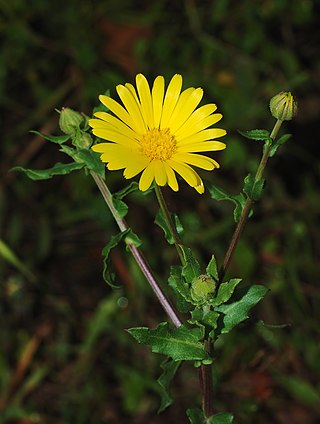
Calendula is a genus of about 15–20 species of annual and perennial herbaceous plants in the daisy family, Asteraceae that are often known as marigolds. They are native to Europe, North Africa, Macaronesia and West Asia, and have their center of diversity in the Mediterranean Region. Other plants known as marigolds include corn marigold, desert marigold, marsh marigold, and plants of the genus Tagetes.
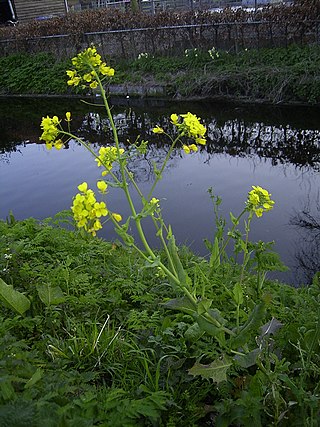
Brassica is a genus of plants in the cabbage and mustard family (Brassicaceae). The members of the genus are informally known as cruciferous vegetables, cabbages, mustard plants, or simply brassicas. Crops from this genus are sometimes called cole crops—derived from the Latin caulis, denoting the stem or stalk of a plant.

Matthiola is a genus of flowering plant in the mustard family Brassicaceae. It is named after Italian naturalist Pietro Andrea Mattioli (1501–1577). The genus contains about 50 species of annual, biennial and perennial herbaceous plants and subshrubs. Many are cultivated for their heavily scented, colorful flowers.

Alnus incana, the grey alder, tag alder or speckled alder, is a species of multi-stemmed, shrubby tree in the birch family, with a wide range across the cooler parts of the Northern Hemisphere. Tolerant of wetter soils, it can slowly spread with runners and is a common sight in swamps and wetlands.

Banksia incana, commonly known as the hoary banksia, is a species of shrub that is endemic to the south-west of Western Australia. It has hairy stems, narrow linear leaves, heads of bright yellow flowers and later, up to thirty-six follicles covered with greyish hairs in each head.

Sphaeralcea incana, with the common names gray globemallow and soft globemallow, is a desert plant in the mallow family (Malvaceae).

Alkanna is a genus of herbaceous plants in the family Boraginaceae. It includes 66 species native to southern and east-central Europe, western Asia, and North Africa.
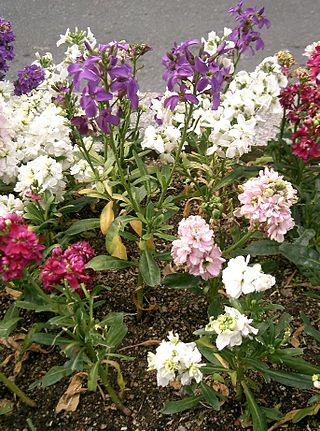
Matthiola incana is a species of flowering plant in the cabbage family Brassicaceae. Common names include Brompton stock, common stock, hoary stock, ten-week stock, and gilly-flower. The common name stock usually refers to this species, though it may also be applied to the whole genus Matthiola. The common name "night-scented stock" or "evening-scented stock" is applied to Matthiola longipetala.

The Valère Basilica, also called Valère castle, is a fortified Roman Catholic church situated in Sion in the canton of Valais in Switzerland. It is located on a hill and faces the Château de Tourbillon, situated on the opposite hill. It is a Swiss heritage site of national significance.
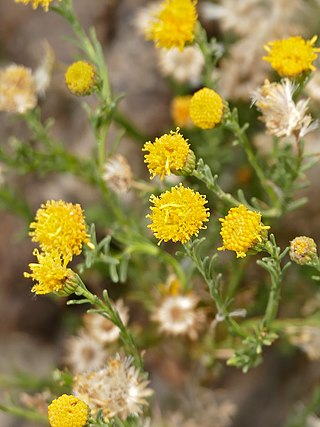
Pentzia is a genus of African plants in the chamomile tribe within the sunflower family. One species (P. incana) is naturalized in Australia and in the southwestern United States.
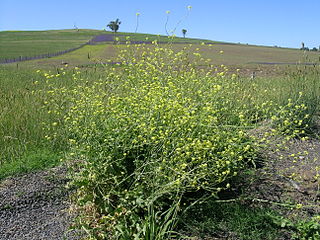
Hirschfeldia incana is a species of flowering plant in the mustard family known by many common names, including shortpod mustard, buchanweed, hoary mustard and Mediterranean mustard. It is the only species in the monotypic genus Hirschfeldia, which is closely related to Brassica. The species is native to the Mediterranean Basin but it can be found in many parts of the world as an introduced species and often a very abundant noxious weed. This mustard is very similar in appearance to black mustard, but is generally shorter. It forms a wide basal rosette of lobed leaves which lie flat on the ground, and it keeps its leaves while flowering. Its stem and foliage have soft white hairs. Unlike black mustard, H. incana is a perennial plant.

Berteroa incana is a species of flowering plant in the mustard family, Brassicaceae. Its common names include hoary alyssum, false hoary madwort, hoary berteroa, and hoary alison. It is a biennial herb native to Eurasia and it has been introduced to western Europe and North America. It is listed as an invasive noxious weed in some areas of United States and Canada

Scutellaria incana, the hoary skullcap or downy skullcap, is a species of perennial flowering plant in the mint family Lamiaceae. It is native to North America and is primarily found in the eastern United States as well as some parts of the Midwest.

Lithostege farinata is a moth of the family Geometridae. It is found from the Iberian Peninsula through north-eastern Germany east to eastern Europe and the Caucasus to western Siberia and Central Asia. In the north, it ranges to southern Scandinavia and the Baltic States. In the south, it is found up to southern Italy and the Balkan Peninsula. It has also been recorded from south-eastern Turkey and north-western Africa. There are old records from Israel and Egypt.

Melaleuca incana, commonly known as grey honey-myrtle, is a plant in the myrtle family, Myrtaceae and is endemic to the south-west of Western Australia and is naturalised in the south of Victoria in Australia. It is commonly grown as a garden plant and produces large numbers of white or creamy yellow flowers, sometimes highly scented, in spring.

Beaufortia incana, commonly known as grey-leaved beaufortia, is a plant in the myrtle family Myrtaceae, and is endemic to southwest of Western Australia. It is a shrub with crowded leaves that appear whitish due to their covering of fine, soft hairs on both surfaces. It has almost spherical heads of red flowers in spring.

Luigi Carlo Giuseppe Bertero was an Italian physicist, physician, naturalist, botanist, bryologist and pteridologist. He explored the West Indies between 1816 and 1821 coinciding with the Venezuelan scientist and later president, José María Vargas in Puerto Rico although there is no evidence of any exchange between them. During his two voyages, February 1828 to September 1830 and between March and May 1830, he collected and described the flora of Chile. He also examined plants native to the Pacific island of Juan Fernandez, as well as Guadeloupe, Haiti, Puerto Rico, and Colombia. He is presumed lost in a shipwreck while sailing from Tahiti to Chile. Bertero´s herbarium specimens were bought after his death by the joint stock company Unio Itineraria and distributed among its members in the exsiccata-like series Unio itineraria 1835.
Argyrochosma incana, the hairy false cloak fern, is a fern known from the southwestern United States through Mexico to Guatemala, and from a disjunct population in the Dominican Republic. It grows on rocky slopes and steep banks, often in forests. Like many of the false cloak ferns, it bears white powder on the underside of its leaves. First described as a species in 1825, it was transferred to the new genus Argyrochosma in 1987, recognizing their distinctness from the "cloak ferns".

Veronica incana, the silver speedwell, is a species of flowering plant in the family Plantaginaceae. It is native to parts of Eastern Europe and Russia, all of Siberia, Mongolia, and northern China, and has been introduced to Czechoslovakia. A number of authorities consider it to be a subspecies of the spiked speedwell Veronica spicata; Veronica spicata subsp. incana. It is a parent of the hybrids Veronica × czemalensis and Veronica × grisea.


















